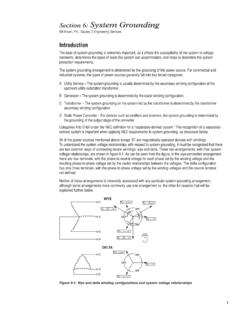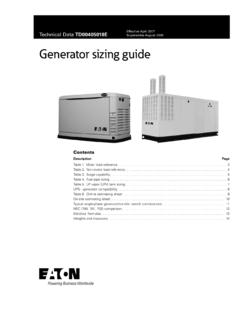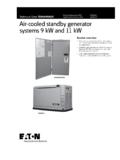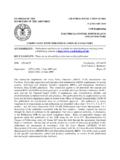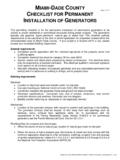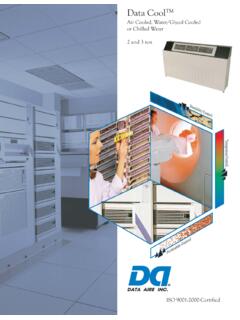Transcription of Section 10: Emergency and Standby Power Systems
1 1 Section 10: Emergency and Standby Power SystemsBill Brown, , Square D Engineering ServicesIntroductionEmergency and Standby Power Systems are designed to provide an alternate source of Power if the normal sourceof Power , most often the serving utility, should fail. As such, reliability of these types of Systems is critical and gooddesign practices are and standardsA.) Classification of Emergency and Standby Power systemsThe classification of Emergency and Standby Power Systems is as follows: Emergency Power system :Defined in IEEE Std.
2 446-1995 [1] as an independent reserve source of electricenergy that, upon failure or outage of the normal source, automatically provides reliable electric Power within aspecified time to critical devices and equipment whose failure to operate satisfactorily would jeopardize the healthand safety of personnel or result in damage to NEC [2] gives a slightly different definition for Emergency Systems as those Systems legally required andclassed as Emergency by municipal, state, federal, or other codes, or by any governmental agency havingjurisdiction.
3 These Systems are intended to automatically supply illumination, Power , or both, to designated areasand equipment in the event of failure of the normal supply or in the event of accident to elements of a systemintended to supply, distribute, and control Power and illumination essential for safety to human life. Standby Power system : Defined in [1] as an independent reserve source of electric energy that, upon failure oroutage of the normal source, provides electric Power of acceptable quality so that the user s facilities maycontinue in satisfactory NEC [2] divides Standby Power Systems into two categories, as follows:Legally Required Standby Systems .
4 Those Systems required and so classed as legally required Standby bymunicipal, state, federal, and other codes or by any governmental agency having jurisdiction. These Systems areintended to automatically supply Power to selected load (other than those classed as Emergency Systems ) in theevent of failure of the normal source. FPN: Legally required Standby Systems are typically installed to serve loads,such as heating and refrigeration Systems , communications Systems , ventilation and smoke removal Systems ,sewage disposal, lighting Systems , and industrial processes that, when stopped during any interruption of thenormal electrical supply, could create hazards or hamper rescue and fire-fighting Standby Systems .
5 Those Systems intended to supply Power to public or private facilities or propertywhere life safety does not depend on the performance of the system . Optional Standby Systems are intended tosupply on-site generated Power to selected loads either automatically or manually. FPN: Optional Standby systemsare typically installed to provide an alternate source of electric Power for such facilities as industrial andcommercial buildings, farms, and residences and to serve loads such as heating and refrigeration Systems , dataprocessing and communications Systems , and industrial processes that, when stopped during any Power outage,could cause discomfort, serious interruption of the process, damage to the product or process, and the )
6 IEEE Standard 446-1995 IEEE Standard 446-1995, IEEE Recommended Practice for Emergency and Standby Power Systems forIndustrial and Commercial Applications[1], is a general engineering reference for the design of these Systems . 2C.) The National Electrical CodeThe National Electrical Code [2] contains requirements for Emergency Systems in Article 700, Legally-RequiredStandby Systems in Article 701, and Optional Standby Systems in Article 702. In addition, Article 445(Generators), 517 (Health Care Facilities), 665 (Integrated Electrical Facilities), and 705 (Interconnected ElectricalPower Production Sources) are all of particular interest for Emergency and Standby Power Systems .
7 The NEC [2] requirements for Emergency and Standby Power Systems are discussed in further detail ) NFPA 110 NFPA 110 [3], Standard for Emergency and Standby Power Systems , defines how Emergency and Standby Power Systems are to be installed and tested. It contains requirements for energy sources, transfer equipment,and installation and environmental considerations. It divides Emergency Power Systems into Types, Classes, and Typerefers to the maximum time that an Emergency Power system can remain unpowered after a failure ofthe normal source.
8 The Types are listed in table 10-1 [3]:Table 10-1: NFPA 110 Emergency Power system types (essentially the same as [3] table (B))The Classof an Emergency Power system refers to the minimum time, in hours, for which the system is designedto operate at its rated load without being refueled or recharged. The Classes for Emergency Power Systems areshown in table 10-2 [3]:Table 10-2: NFPA 110 Emergency Power system classes (essentially the same as [3] table (B))The Levelof an Emergency Power system refers to the level of equipment installation, performance, andmaintenance requirements.
9 The Levels for Emergency Power Systems are shown in table 10-3 [3]:Table 10-3: NFPA Emergency Power system levelsTypePower restoration timeUBasically Uninterruptible (UPS Systems )1010 sec6060 sec120120 secMManual stationary or nonautomatic no time limitClassPower restoration hr. (5 min.) hr. (15 min.)22 time, in hours, as required by the application, code, or Installed1 When failure of the equipment to perform could result in loss of human life or serious injuries2 When failure of the equipment to perform is less critical to human life and safety and where the authority having jurisdiction shall permit a higher degree of flexibility than that provided by a level 1 system3E.
10 NFPA 101 NFPA 101 [4], Life Safety Code, addresses those construction, protection, and occupancy features necessary tominimize danger to life from fire, including smoke, fumes, or panic. It defines the requirements for what systemsthe Emergency Power system will ) NFPA 99 NFPA 99 defines establishes criteria to minimize the hazards of fire, explosion, and electricity in health carefacilities. It defines several specific features of electric Power Systems for these facilities. Reasons for applicationEmergency and Standby Power Systems are generally designed into the over-all electrical system for one of thefollowing two reasons: Legal Requirements As required by the NEC [2] NFPA 101 [4], NFPA 99 [5], and other local, state, and federalcodes and requirements.
